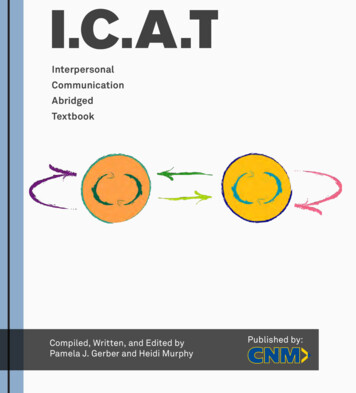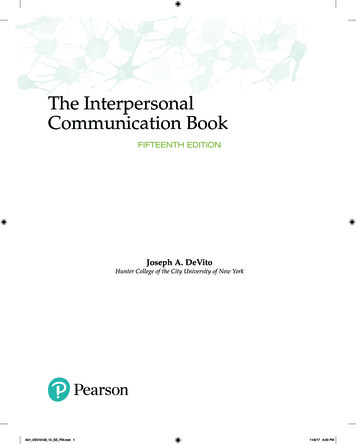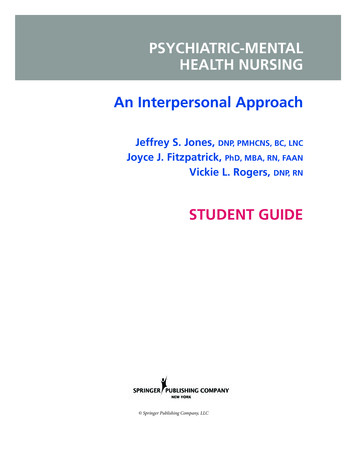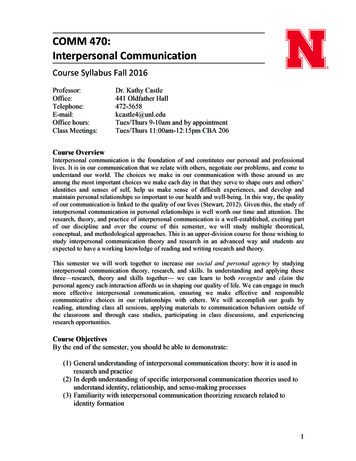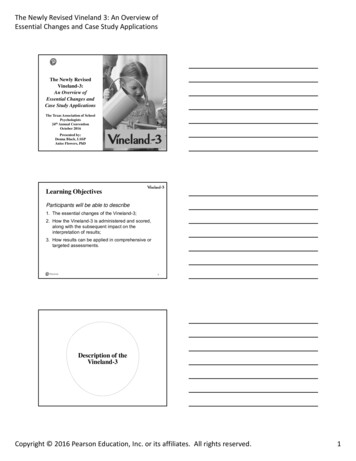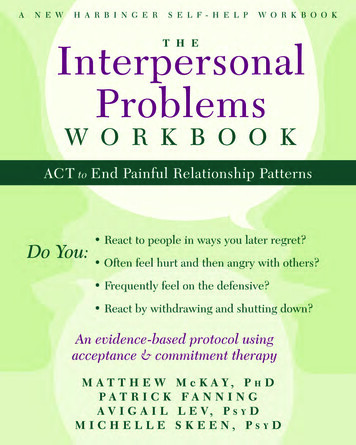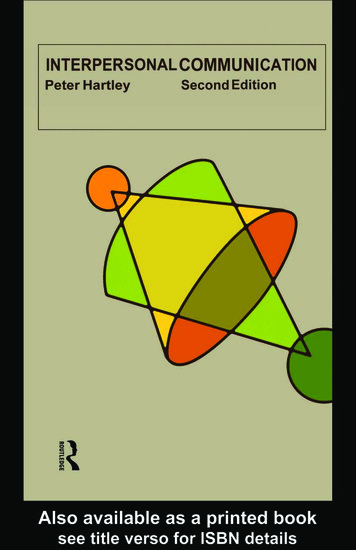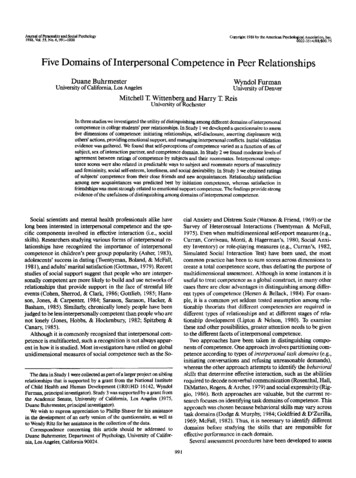
Transcription
Journal of Personality and Social Psychology1988, Vol. 55, No. f , 991-1008Copyright 1988 by the American Psychological Association, Inc.0022-3514/88/ 00.75Five Domains of Interpersonal Competence in Peer RelationshipsDuane BuhrmesterUniversity of California, Los AngelesWyndol FurmanUniversity of DenverMitchell T. Wittenberg and Harry T. ReisUniversity of RochesterIn three studies we investigated the utility of distinguishing among different domains of interpersonalcompetence in college students' peer relationships. In Study 1 we developed a questionnaire to assessfive dimensions of competence: initiating relationships, self-disclosure, asserting displeasure withothers' actions, providing emotional support, and managing interpersonal conflicts. Initial validationevidence was gathered. We found that self-perceptions of competence varied as a function of sex ofsubject, sex of interaction partner, and competence domain. In Study 2 we found moderate levels ofagreement between ratings of competence by subjects and their roommates. Interpersonal competence scores were also related in predictable ways to subject and roommate reports of masculinityand femininity, social self-esteem, loneliness, and social desirability. In Study 3 we obtained ratingsof subjects' competence from their close friends and new acquaintances. Relationship satisfactionamong new acquaintances was predicted best by initiation competence, whereas satisfaction infriendships was most strongly related to emotional support competence. The findings provide strongevidence of the usefulness of distinguishing among domains of interpersonal competence.Social scientists and mental health professionals alike havecial Anxiety and Distress Scale (Watson & Friend, 1969) or thelong been interested in interpersonal competence and the specific components involved in effective interaction (i.e., socialSurvey of Heterosexual Interactions (Twentyman & McFall,1975). Even when multidimensional self-report measures (e.g.,Curran, Corriveau, Monti, & Hagerman's, 1980, Social Anxiety Inventory) or role-playing measures (e.g., Curran's, 1982,Simulated Social Interaction Test) have been used, the mostcommon practice has been to sum scores across dimensions tocreate a total competence score, thus defeating the purpose ofskills). Researchers studying various forms of interpersonal relationships have recognized the importance of interpersonalcompetence in children's peer group popularity (Asher, 1983),adolescents' success in dating (Twentyman, Boland, & McFall,1981), and adults' marital satisfaction (Gottman, 1979). Recentstudies of social support suggest that people who are interper-multidimensional assessment. Although in some instances it isuseful to treat competence as a global construct, in many othercases there are clear advantages in distinguishing among different types of competence (Hersen & Bellack, 1984). For exam-sonally competent are more likely to build and use networks ofrelationships that provide support in the face of stressful lifeevents (Cohen, Sherrod, & Clark, 1986; Gottlieb, 1985; Hansson, Jones, & Carpenter, 1984; Sarason, Sarason, Hacker, &Basham, 1985). Similarly, chronically lonely people have beenjudged to be less interpersonally competent than people who areple, it is a common yet seldom tested assumption among relationship theorists that different competencies are required indifferent types of relationships and at different stages of rela-not lonely (Jones, Hobbs, & Hockenbury, 1982; Spitzberg &Canary, 1985).tionship development (Lipton & Nelson, 1980). To examinethese and other possibilities, greater attention needs to be givenAlthough it is commonly recognized that interpersonal com-to the different facets of interpersonal competence.Two approaches have been taken in distinguishing compo-petence is multifaceted, such a recognition is not always apparent in how it is studied. Most investigators have relied on globalnents of competence. One approach involves partitioning competence according to types of interpersonal task domains (e.g.,initiating conversations and refusing unreasonable demands),unidimensional measures of social competence such as the So-whereas the other approach attempts to identify the behavioralskills that determine effective interaction, such as the abilitiesThe data in Study 1 were collected as part of a larger project on siblingrelationships that is supported by a grant from the National Instituteof Child Health and Human Development (1R01HD 16142, WyndolFurman, principal investigator). Study 3 was supported by a grant fromthe Academic Senate, University of California, Los Angeles (3975,Duane Buhrmester, principal investigator).We wish to express appreciation to Phillip Shaver for his assistancein the development of an early version of the questionnaire, as well asto Wendy Ritz for her assistance in the collection of the data.Correspondence concerning this article should be addressed toDuane Buhrmester, Department of Psychology, University of California, Los Angeles, California 90024.required to decode nonverbal communication (Rosenthal, Hall,DiMatteo, Rogers, & Archer, 1979) and social expressivity (Riggio, 1986). Both approaches are valuable, but the current research focuses on identifying task domains of competence. Thisapproach was chosen because behavioral skills may vary acrosstask domains (Dodge & Murphy, 1984; Goldfried & D'Zurilla,1969; McFall, 1982). Thus, it is necessary to identify differentdomains before studying the skills that are responsible foreffective performance in each domain.Several assessment procedures have been developed to assess991
992BUHRMESTER, FURMAN, WITTENBERG, AND REISmultiple task domains of competence. For example, severalfactor-analytically derived questionnaires examine multiple dimensions of social anxiety (Richardson & Tasto, 1976; Watson& Friend, 1969) and assertiveness (Galassi & Galassi, 1980;Gambrill & Richey, 1975). Similarly, role-playing procedureshave been devised to assess multiple interaction situations (Curran, 1982; Fisher-Beckfield & McFall, 1982). However, littleempirical work has evaluated the validity and utility of distinguishing among the domains of competence that these measures assess (see Levenson & Gottman. 1978, for a notable exception). Although there has been considerable research examining the specific skills and behavioral processes associated withcertain domains of competence (e.g., initiating interactions),less work has examined correlations with personological variables such as masculinity-femininity and loneliness. What isneeded is research demonstrating that scores for different competence domains are related differentially to various aspects ofsocial functioning. Such research would both explicate the nature of different domains of interpersonal competence and clarify the roles that these domains of competence play in variousarenas of psychosocial functioning.We began by identifying five domains of competence that areknown to have theoretical relevance to psychosocial functioning. The first of three studies was intended to establish that thefive domains are empirically separable and are useful in examining sex and sex-of-partner differences in interpersonal competence. In the second study, we compared self-perceptions androommate perceptions of interpersonal competence. In addition, self- and roommate ratings of subjects' personalities werecollected in order to examine whether each domain of competence is differentially related to various features of social functioning. Finally, in the third study we investigated the rolesplayed by various domains of competence in two types of relationships: a new acquaintanceship and a stable friendship.Study 1We drew on existing theoretical and empirical literature toidentify several domains of interpersonal competence. Threeconsiderations guided our search. First, we were interested indomains that were reasonably broad and comprehensive. Second, the domains of behavior needed to have theoretical relevance to important psychological phenomena. This dictatedthat we broadly survey the clinical, social, and developmentalpsychology literatures to identify conceptually significant interpersonal tasks. Finally, each domain needed to be conceptuallyand empirically distinguishable from the other domains. Inpractice this meant that the existing literature needed to indicate that there was good reason to expect that competence in atask domain be only moderately correlated with competence inother domains.On the basis of these criteria, we identified five domains ofinterpersonal tasks: (a) initiation of interactions and relationships, (b) assertion of personal rights and displeasure with others, (c) self-disclosure of personal information, (d) emotionalsupport of others, and (e) management of interpersonal conflicts that arise in close relationships. The first two domains,initiation of interactions and assertion, have commonly beenstudied in the behavioral research on assertiveness (Galassi &Galassi, 1980; Lipton & Nelson, 1980; Rathus, 1973;Schroeder, Rakos, & Moe, 1983). The third domain, disclosureof personal information, has been emphasized as important bycommunication researchers (Dickson-Markman, 1986), socialpsychologists (Chelune, Sulton, & Williams, 1980; Jourard,1971), and marital researchers (Gottman, 1979; Tolstedt &Stokes, 1984). The fourth domain, emotional support, refers toproviding comfort to others when they are experiencing problems or distress (Barker & Lemle, 1984; Gottlieb, 1985). Finally, management of interpersonal conflicts has been emphasized as critical in the behavioral marital literature (Convey &Dengerink, 1984; Gottman, 1979). Although alternative listscould be generated, we believe that the present one providesrelatively comprehensive coverage of important interpersonaldomains.Next, we constructed a measure to assess interpersonal competence in these five domains. The long-range goal was to have apsychometrically sound questionnaire to evaluate interactionalcompetence from several perspectives, including self-ratings,ratings by interaction partners, and ratings by trained judges.We began by developing a self-report version of the measure.The measure was constructed by adapting items used in severalexisting measures (Galassi, Delo, Galassi, & Bastien, 1974; Levenson & Gottman, 1978; Richardson & Tasto, 1976) and bywriting original items where needed. In the first study we investigated whether this questionnaire assessed five empirically distinguishable domains of competence and whether scale scoresfor these domains were satisfactorily reliable. Also, several conceptually related variables were assessed to examine the construct validity of the new questionnaire.In addition to the psychometric validation of the measure, asecond goal of the research was to investigate self-perceptionsof interpersonal competence in their own right. Such self-perceptions may be important determinants of self-efficacy, whichin turn may determine whether a person attempts to undertakea behavior (Bandura, 1986). Similarly, lack of perceived competence may elicit anxiety and undermine a person's ability tointeract appropriately. Therefore, we sought to determine howself-perceptions of competence varied as a function of socialcontext.We investigated three interrelated substantive issues. Thefirst concerned the degree of generalizability of perceived competence across task domains. Past factor-analytic studies havefound that the dimensions underlying questionnaires are uncorrelated (Curran et al., 1980; Galassi & Galassi, 1980; Gambrill& Richey, 1975). These results, however, may in part be an artifact of orthogonal factor rotation procedures that mathematically required uncorrelated dimensions. The few role-playingstudies that have reported the correlations among competencescores for different task domains have found moderate levels ofgeneralizability (Farrell, Curran, Zwick, & Monti, 1983; Wailander, Conger, Cohen, & Conger, 1985). On the basis of thesefindings, we expected that ratings of the five domains would bemoderately intercorrelated.A related issue concerned the comparison of perceived competence levels across different types of relationship partners.Some investigators have found that the level of competence varies, depending on the sex and familiarity of the interaction partner (Eisler, Hersen, Miller, & Blanchard, 1975), with cross-sex
993INTERPERSONAL COMPETENCEinteractions with new acquaintances being particularly problematic. We tendered no specific hypotheses but suspected thatthe levels of competence in interactions with same-sex versuscross-sex partners would vary with the domain of competence.The final issue concerned sex differences in interpersonalcompetence. The results from past studies have been mixed,with most investigators reporting no sex differences (Gormally,1982; Snodgrass, 1985), others finding men more competentthan women (Hollandsworth & Walls, 1977), and still othersfinding women more competent than men (Lipton & Nelson,1980; Pitcher & Meikle, 1980; Reis et al., 1982). We expectedthat sex differences would vary as a function of task domain.Specifically, men should show greater competence in domainsthat call for instrumental forms of behavior (relationship initiation and negative assertion), whereas women should reportgreater competence in domains that call for expressive forms ofbehavior (self-disclosure and emotional support). No a prioriprediction was made concerning sex differences in conflict management competence.MethodSubjectsThree samples of subjects participated. Sample 1 consisted of 123male and 97 female undergraduates enrolled in introductory psychology at the University of Denver. Sample 2 consisted of 83 male and119 female undergraduates enrolled in introductory psychology at theUniversity of California, Los Angeles. Sample 3 consisted of 13 maleand 18 female undergraduates enrolled in an advanced psychologycourse at the University of California, Los Angeles. Sample 3 was usedonly to gather 4-week test-retest reliability data on the InterpersonalCompetence Questionnaire. All participants received course credit fortaking part.Procedure and MeasuresParticipants in Sample 1 were given a packet of Questionnaires thatthey were instructed to complete and return to the experimenter. Thepacket took approximately 1 hr to complete. Several other questionnaires were included as part of another study and are not discussed here.The questionnaires relevant to the current study included the following:Interpersonal Competence Questionnaire (ICQ). This 40-item questionnaire was designed to assess five domains of interpersonal competence: (a) initiating relationships, (b) disclosing personal information,(c) asserting displeasure with others, (d) providing emotional supportand advice, and (e) managing interpersonal conflict. In a preliminarystudy 10 items were written to assess each of the five hypothesized domains. This 50-item scale was administered to a pilot sample of 121college undergraduates. Factor analysis revealed rive factors corresponding to the hypothesized domains of competence. The current 40-itemquestionnaire was constructed by selecting the 8 items that loaded highest on each of the five factors.Each item of the ICQ briefly describes a common interpersonal situation. (See Table 1 for a listing of items.) Respondents were instructed touse Levenson and Gottman's (1978) 5-point rating scale to indicatetheir level of competence and comfort in handling each type of situation(1 "I'm poor at this; I'd feel so uncomfortable and unable to handlethis situation, I'd avoid it if possible"; 2 "I'm only fair at this; I'd feeluncomfortable and would have lots of difficulty handling this situation"; 3 "I'm OK at this; I'd feel somewhat uncomfortable and havesome difficulty handling this situation"; 4 "I'm good at this; I'd feelquite comfortable and able to handle this situation"; 5 "I'm EX-TREMELY good at this; I'd feel very comfortable and could handle thissituation very well"). Subjects made two ratings per item. In one column, they indicated how they would react with a same-sex friend, andin the second column they rated their response with an opposite-sexdate or romantic partner.Dating andAssertiveness Questionnaire (DAQ; Levenson & Gottman,1978). This 18-item self-report questionnaire assessed two social skills:dating skill (e.g., conversation and initiation skills) and assertiveness.Subjects responded on a 5-point scale indicating the degree of comfortfelt and the ability to handle each situation. This questionnaire was included to examine the concurrent validity of the Initiation and NegativeAssertion scales of the ICQ.Interpersonal activities. Subjects were asked to rate their frequencyof dating and their frequency of initiating dates. Each rating was a singleitem on a 5-point scale.Emotional experiences. A modified version of the mood checklistdeveloped by Lebo and Nesselroade (1978) was used to assess two broaddimensions of emotional experience: depression-anxiety and well-being-energy. Subjects rated how often they experienced different emotions on 5-point scales (0 never to 4 very frequently or always). Thereliabilities (Cronbach alphas) of the two 30-item scales were satisfactory: .89 for Depression-Anxiety and .91 for Well-being-Energy. Alsoadministered was a 10-item version of the UCLA Loneliness Scale (Russell, Peplau, & Cutrona, 1980), which had adequate reliability, .82.Participants in Sample 2 also completed the ICQ. In addition, theyfilled out the following measures:Social Skills Inventory (SSI; Riggio, 1986). This is a self-report measure designed to assess nonverbal and verbal social communicationskills. The 105-item questionnaire yields seven scales: Emotional Expressivity, Emotional Sensitivity, Emotional Control, Social Expressivity, Social Sensitivity, Social Control, and Social Manipulation. A seriesof validation studies have demonstrated the reliability and the convergent and discriminant validity of the measure for use with college populations. The response scale for each item is a 9-point scale (ranging from-4 not at all true to 4 very true of me). This measure was includedto investigate concurrent validity of the ICQ scales and to determinethe extent to which different communication skills are associated withparticular ICQ competence domains.Social Reticence Scale (SRS; Jones & Russell, 1982). This is a 22item measure of shyness that has demonstrated reliability and validity.It was included in the study primarily to investigate the concurrent validity of the initiation subscale of the ICQ.ResultsDistinctiveness and Generalizability of CompetenceDomainsTo determine whether interpersonal competence ratings fellinto five distinguishable domains, a confirmatory factor analysis was conducted on the 40 items of the ICQ by using Bentler's(1985) EQS structural equation program. We tested a five-factor simple-structure model in which each ICQ item was restricted to load on its one designated factor. Ratings for samesex peers and opposite-sex peers were analyzed separately. Itemloadings and error variances were free to vary, whereas latentfactor variances were set to 1.0 and factors were allowed to covary. There were marked differences between generalized leastsquares (GLS) and maximum likelihood (ML) solutions. GLSsolutions yielded x2(730) 1,247.94, p .001, for same-sexratings, and x2(730) 1,237.26, p .001, for opposite-sex ratings, with Bentler-Bonett (1980) fit indexes of .96 and .97, respectively. Table 1 contains the factor coefficients for the GLS
994BUHRMESTER, FURMAN, WITTENBERG, AND REISTable 1Factor Model Coefficientsof the Interpersonal Competence Questionnaire (ICQ)ICQ model (factor) coefficientsSame-sex ratingsItems grouped by ICQ scaleIIIHIIVOpposite-sex ing or suggesting to someone new that you get together and do something, e.g.,go out together.Finding and suggesting things to do with new people whom you find interestingand attractive.Carrying on conversations with someone new whom you think you might like toget to know.Being an interesting and enjoyable person to be with when first getting to knowpeople.Introducing yourself to someone you might like to get to know (or date).Calling (on the phone) a new date/acquaintance to set up a time to get togetherand do something.Presenting good first impressions to people you might like to become friends with(or date).Going to parties or gatherings where you don't know people well in order to startup new tive Assertion2. Telling a companion you don't like a certain way he or she has been treating you.7. Saying "no" when a date/acquaintance asks you to do something you don't wantto do.12. Turning down a request by a companion that is unreasonable.17. Standing up for your rights when a companion is neglecting you or beinginconsiderate.22. Telling a date/acquaintance that he or she is doing something that embarrassesyou.27. Confronting your close companion when he or she has broken a promise.32. Telling a companion that he or she has done something to hurt your feelings.37. Telling a date/acquaintance that he or she has done something that made . Revealing something intimate about yourself while talking with someone you'rejust getting to know.8. Confiding in a new friend/date and letting him or her see your softer, moresensitive side.13. Telling a close companion things about yourself that you're ashamed of.18. Letting a new companion get to know the "real you."23. Letting down your protective "outer shell" and trusting a close companion.28. Telling a close companion about the things that secretly make you feel anxious orafraid.33. Telling a close companion how much you appreciate and care for him or her.38. Knowing how to move a conversation with a date/acquaintance beyondsuperficial talk to really get to know each other.60727053646777536560615653515744Emotional Support4. Helping a close companion work through his or her thoughts and feelings about amajor life decision, e.g., a career choice.9. Being able to patiently and sensitively listen to a companion "let off steam" aboutoutside problems s/he is having.14. Helping a close companion get to the heart of a problem s/he is experiencing.19. Helping a close companion cope with family or roommate problems.24. Being a good and sensitive listener for a companion who is upset.29. Being able to say and do things to support a close companion when s/he is feelingdown.34. Being able to show genuine empathetic concern even when a companion'sproblem is uninteresting to you.39. When a close companion needs help and support, being able to give advice in waysthat are well received.52535164675750526750525465635054
INTERPERSONAL COMPETENCE995Table 1 (continued)ICQ model (factor) coefficientsSame-sex ratingsItems grouped by ICQ scaleIIIHIOpposite-sex ratingsIVIIIIIIIVConflict Management5. Being able to admit that you might be wrong when a disagreement with a closecompanion begins to build into a serious fight.10. Being able to put begrudging (resentful) feelings aside when having a fight with aclose companion.1 5. When having a conflict with a close companion, really listening to his or hercomplaints and not trying to "read" his/her mind.20. Being able to take a companion's perspective in a fight and really understand his orher point of view.25. Refraining from saying things that might cause a disagreement to build into a bigfight.30. Being able to work through a specific problem with a companion without resortingto global accusations ("you always do that").35. When angry with a companion, being able to accept that s/he has a valid point ofview even if you don't agree with that view.40. Not exploding at a close companion (even when it is justified) in order to avoid adamaging conflict.60506862656064697778655870716764Note. Values listed in Columns I-V are standardized path coefficients (factor loadings) from Bentler's (1985) EQS structural equation programgeneralized least squares confirmatory structural model. Coefficients from maximum likelihood model were very similar to those presented in thetable.solution. Although the overall chi-square goodness-of-fit testsfor these models do not satisfy strict statistical significance tests,with poor Bentler-Bonett fit indexes of .74 and .73, respectively.The pattern of ML factor coefficients, however, was very similarthis is typical of models that involve a large number of variablesto that of the GLS solution.and subjects. As Bentler and Bonett (1980) noted, "In very largesamples virtually all models that one might consider would haveto be rejected as statistically untenable" (p. 591). Therefore,the Bentler-Bonett index is the more appropriate coefficient forevaluating the current models because it is sensitive to variablessuch as sample size and number of parameters. Because fit in-Often, such large discrepancies in fit across GLS and ML solutions occur when data do not meet the conditions of multivariate normality. Examination of the multivariate kurtosis estimates revealed that, in fact, the data deviated from multivariatenormality. Under these conditions Bentler (1985) suggested thatit is more appropriate to evaluate the models by using arbitrarydistribution theory. Unfortunately, existing computer pro-dexes of .90 or greater represent satisfactory degrees of fit (Bentler & Bonett, 1980), the current GLS models appear to fit thedata very well. The ML solutions, however, did not fit nearly asgrams cannot accommodate models that involve as many as 40observed variables (25 is the largest number that can be accommodated). To adapt to these constraints, the total number ofwell, yielding *2(730) 1,687.60, p .001, for same-sex ratings, and x2(730) 1,817.99, p .001, for opposite-sex ratings,observed variables was reduced to 20 by averaging pairs of ICQTable 2Correlations Among Self-Reported Interpersonal Competence Questionnaire (ICQ) Ratings of InteractionsWith Friends and Romantic PartnersICQ scale1.2.3.4.5.6.7.8.9.10.Initiation with friendAssertion with friendDisclosure with friendSupport with friendConflict with friendInitiation with dateAssertion with dateDisclosure with dateSupport with dateConflict with )42502422(86)413620(82)4530(87)44Note. Numbers in parentheses are Cronbach alpha internal consistency coefficients. All correlation coefficients are significant at p .01.(77)
996BUHRMESTER, FURMAN, WITTENBERG, AND REISitems that were intended to assess the same domain of competence. A five-factor simple-structure model with four indicatorsMeans and Standard Deviations of Interpersonal Competenceper factor was tested by using the arbitrary distribution theory(AGLS) procedure in Bentler's EQS program. The analysesQuestionnaire (ICQ) Ratings of InteractionsWith Friends and Romantic PartnersTable 3yielded x2(160) 510.75, p .001, for same-sex ratings, andX2(160) 506.16, p .001, for opposite-sex ratings, with fitindexes of .90 and .91, respectively. These fit indexes meet minimal levels of goodness of fit, indicating that the confirmatoryRomanticpartnerICQ 703.563.630.660.66Negative motional flict factor analyses support the five-factor simple-structure modelhypothesized to underlie the items of the ICQ.Next, we examined the generalizability of the factor structureacross same-sex ratings and opposite-sex ratings. Whereas itwould have been desirable to use structural modeling techniques to directly evaluate the equivalence of loadings acrossthe two types of ratings, in practice this proved beyond themeans of our computing facility, owing to the large number ofvariables involved. Instead, a more traditional approach toevaluating concordance of factor loadings was adopted (Wrigley& Neuhaus, 1955). The coefficients for corresponding ML factors were high (range .92-.98, M .96), indicating that thefactor models were very similar.Scores for each of the five dimensions were derived by averaging the eight items representing each factor. As shown in Table2, internal consistency reliabilities (Cronbach alphas) were satisfactory, ranging from .77 to .87, with a mean of .83. Table 2also contains intercorrelations among the 10 competence measures. Scale scores were moderately correlated across the fivecompetence domains, ranging from r .26 to r .54, meanr .42, indicating moderate levels of generalizability across thefive domains of self-reported competence. These correlationswere very similar to those found among the latent factors in theML models, which ranged from r .29 to r .63, mean r .44. Correlations between corresponding dimensions of thefriend and romantic partner ratings were high, ranging from r .68 to r .84, indicating that individual differences were quitestable across ratings of these two types of interaction partners.Because they were highly correlated, ratings of competencewith friends and romantic partners were averaged to create fiveoverall competence scores. These composite scores were usedin all subsequent correlational analyses. The Cronbach alphacoefficients for these 16-item composite scales were high, ranging from .86 to .91.Four-week test-retest reliability correlations for each of thefive scales were high: Initiation, r .89; Negative Assertion, r .79; Disclosure, r .75; Emotional Support, r .76; and Conflict Management, r - .69.Effectsof Sex and Sex of Interaction Partne
Simulated Social Interaction Test) have been used, the most common practice has been to sum scores across dimensions to create a total competence score, thus defeating the purpose of multidimensional assessment. Although in some instances it is useful to treat competence as a global construct, in many other
